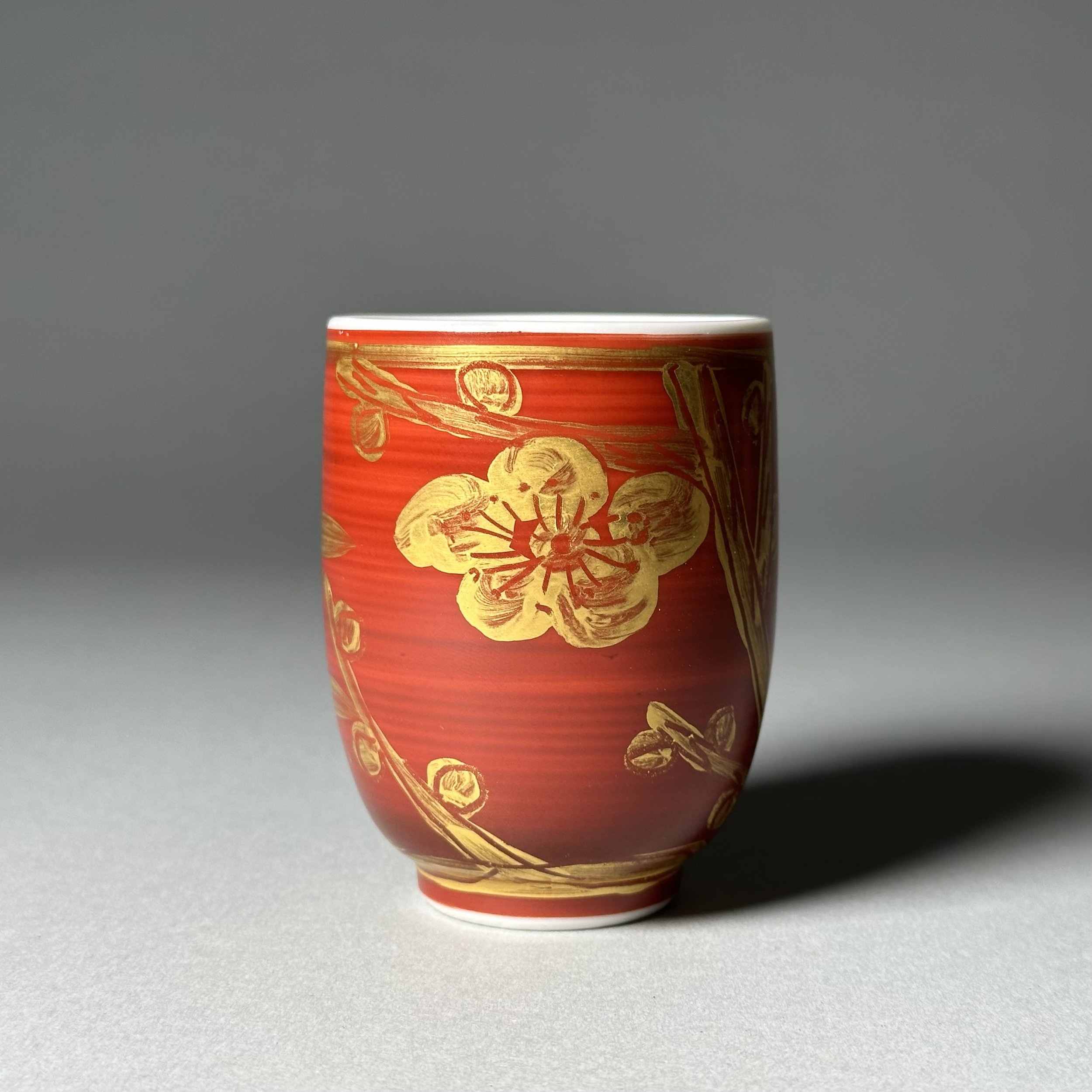Red and gold yunomi by Kondo Yuzo (1902-1985)
Kyoto, Japan
Showa Period (1926-1989), c. 1980
Of tall cylindrical form painted with bamboo and plum blossom amongst clouds in gold over an iron-red ground, with an underglaze blue mark to the base. 8cm high, 6.25cm diameter.
Kondo Yuzo (1902-1985) was born in Kyoto and trained as a ceramicist at the Kyoto Municipal Ceramics Institute. He became assistant to Tomimoto Kenkichi and threw many of his early ceramics for him. Tomimoto recognised his skill at throwing ceramics but his weakness at decorating them. He encouraged Kondo to return to school to learn to draw which he did and a few years later started decorating his ceramics in large, bold imagery drawing on a restricted vocabulary of subjects. In 1924 he set up his own studio below Kiyomizu Temple where he worked throughout his life. After 1945 he decided to dedicate himself to sometsuke (blue and white) decoration and was designated a Living National Treasure for this work in 1977. As impressive as his decoration is, he also needs to be remembered for the graceful forms of his ceramics. In later life these often had a gold ground, or red ground with gold decoration, a harking back to the richness of Imperial era Kyoto. He passed away in Kyoto in 1985.
Kyoto, Japan
Showa Period (1926-1989), c. 1980
Of tall cylindrical form painted with bamboo and plum blossom amongst clouds in gold over an iron-red ground, with an underglaze blue mark to the base. 8cm high, 6.25cm diameter.
Kondo Yuzo (1902-1985) was born in Kyoto and trained as a ceramicist at the Kyoto Municipal Ceramics Institute. He became assistant to Tomimoto Kenkichi and threw many of his early ceramics for him. Tomimoto recognised his skill at throwing ceramics but his weakness at decorating them. He encouraged Kondo to return to school to learn to draw which he did and a few years later started decorating his ceramics in large, bold imagery drawing on a restricted vocabulary of subjects. In 1924 he set up his own studio below Kiyomizu Temple where he worked throughout his life. After 1945 he decided to dedicate himself to sometsuke (blue and white) decoration and was designated a Living National Treasure for this work in 1977. As impressive as his decoration is, he also needs to be remembered for the graceful forms of his ceramics. In later life these often had a gold ground, or red ground with gold decoration, a harking back to the richness of Imperial era Kyoto. He passed away in Kyoto in 1985.
Kyoto, Japan
Showa Period (1926-1989), c. 1980
Of tall cylindrical form painted with bamboo and plum blossom amongst clouds in gold over an iron-red ground, with an underglaze blue mark to the base. 8cm high, 6.25cm diameter.
Kondo Yuzo (1902-1985) was born in Kyoto and trained as a ceramicist at the Kyoto Municipal Ceramics Institute. He became assistant to Tomimoto Kenkichi and threw many of his early ceramics for him. Tomimoto recognised his skill at throwing ceramics but his weakness at decorating them. He encouraged Kondo to return to school to learn to draw which he did and a few years later started decorating his ceramics in large, bold imagery drawing on a restricted vocabulary of subjects. In 1924 he set up his own studio below Kiyomizu Temple where he worked throughout his life. After 1945 he decided to dedicate himself to sometsuke (blue and white) decoration and was designated a Living National Treasure for this work in 1977. As impressive as his decoration is, he also needs to be remembered for the graceful forms of his ceramics. In later life these often had a gold ground, or red ground with gold decoration, a harking back to the richness of Imperial era Kyoto. He passed away in Kyoto in 1985.





